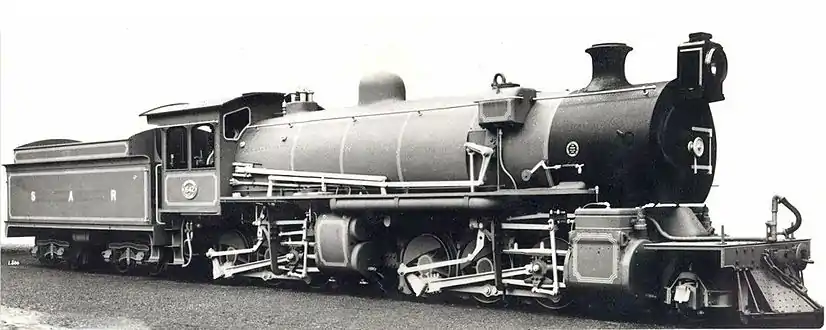| South African Class MC1 2-6-6-0 | |||||||||||||||||||||||||||||||||||||||||||||||||||||||||||||||||||||||||||||||||||||||||||||||||||||||||||||||||||
|---|---|---|---|---|---|---|---|---|---|---|---|---|---|---|---|---|---|---|---|---|---|---|---|---|---|---|---|---|---|---|---|---|---|---|---|---|---|---|---|---|---|---|---|---|---|---|---|---|---|---|---|---|---|---|---|---|---|---|---|---|---|---|---|---|---|---|---|---|---|---|---|---|---|---|---|---|---|---|---|---|---|---|---|---|---|---|---|---|---|---|---|---|---|---|---|---|---|---|---|---|---|---|---|---|---|---|---|---|---|---|---|---|---|---|---|
.jpg.webp) SAR Class MC1 with engine driver Mr. Kok, c. 1930 | |||||||||||||||||||||||||||||||||||||||||||||||||||||||||||||||||||||||||||||||||||||||||||||||||||||||||||||||||||
| |||||||||||||||||||||||||||||||||||||||||||||||||||||||||||||||||||||||||||||||||||||||||||||||||||||||||||||||||||
| |||||||||||||||||||||||||||||||||||||||||||||||||||||||||||||||||||||||||||||||||||||||||||||||||||||||||||||||||||
| |||||||||||||||||||||||||||||||||||||||||||||||||||||||||||||||||||||||||||||||||||||||||||||||||||||||||||||||||||
| |||||||||||||||||||||||||||||||||||||||||||||||||||||||||||||||||||||||||||||||||||||||||||||||||||||||||||||||||||
The South African Railways Class MC1 2-6-6-0 of 1914 was a steam locomotive.
In 1914 the South African Railways placed fifteen Class MC1 Mallet articulated compound steam locomotives with a 2-6-6-0 wheel arrangement in service.[1][2]
Manufacturer
Orders for an improved version of the Class MC were placed with the North British Locomotive Company in 1913. When the fifteen locomotives were delivered and placed in service in May 1914, they were designated Class MC1 and numbered in the range from 1634 to 1648.[1][2][3][4]
Characteristics
The Class MC1 were duplicates of the Class MC in most respects, to the extent that the majority of spare parts for the two classes were interchangeable. Improvements consisted mainly of 1⁄2 inch (13 millimetres) larger diameter high-pressure and low-pressure cylinders and a redesigned boiler which included a superheater instead of the saturated steam boiler of the Class MC. The high-pressure cylinders of the hind engine unit were equipped with piston valves while the low-pressure cylinders of the front engine unit were equipped with slide valves.[1][2][3]
An externally obvious difference was the main steam pipes from the dome to the high-pressure cylinders, which was no longer arranged vertically down directly to the cylinders along the outside of the boiler, but internally via the superheater in the smokebox and from there along the underside of the running boards back to the cylinders. The result was a much better performing locomotive with an increased tractive effort brought about by the larger cylinders.[1][2][3]
The locomotives were delivered with Type MP1 tenders with a coal capacity of 10 long tons (10.2 tonnes) and a water capacity of 4,250 imperial gallons (19,300 litres). The same tender was used by altogether sixteen locomotive classes, but those of the Class MC1 were fitted with a radial type of drawgear.[3]
Modifications
When the coupled wheel tyres had to be renewed, the diameter of the wheels was increased from 45+1⁄2 inches (1,156 millimetres) to 46 inches (1,168 millimetres). This reduced the tractive effort from 46,414 pounds-force (206 kilonewtons) at 50% of boiler pressure to 45,900 pounds-force (204 kilonewtons). Unlike all other locomotive types where the SAR reported tractive effort at 75% of boiler pressure, it followed an ultra-conservative practice of reporting that of all Mallet locomotives at 50%.[3][5]
Service
The Class MC1 was placed in service on the coal line from Witbank to Germiston. In later years, some also saw service on the Natal mainline and the Cape Midland System. A number of them were transferred to the Cape Western System where they served as banking engines up the Hex River Railpass between De Doorns and Touws River.[1][2][5][6]
The locomotives were all finally withdrawn from service and scrapped during 1937.[3]
Illustration
The main picture shows driver Kok with his locomotive, c. 1930, while the following serve to illustrate both sides of the locomotive as well as the lined livery which was in use on the SAR when the locomotives were introduced.
.jpg.webp) No. 1635 in service as banking engine at De Doorns, c. 1930
No. 1635 in service as banking engine at De Doorns, c. 1930
 Works picture of Class MC1 no. 1642, c. 1914
Works picture of Class MC1 no. 1642, c. 1914
References
- 1 2 3 4 5 Holland, D. F. (1972). Steam Locomotives of the South African Railways. Vol. 2: 1910-1955 (1st ed.). Newton Abbott, England: David & Charles. pp. 21–22. ISBN 978-0-7153-5427-8.
- 1 2 3 4 5 Paxton, Leith; Bourne, David (1985). Locomotives of the South African Railways (1st ed.). Cape Town: Struik. p. 85. ISBN 0869772112.
- 1 2 3 4 5 6 Espitalier, T.J.; Day, W.A.J. (1945). The Locomotive in South Africa - A Brief History of Railway Development. Chapter VII - South African Railways (Continued). South African Railways and Harbours Magazine, May 1945. p. 349.
- ↑ North British Locomotive Company works list, compiled by Austrian locomotive historian Bernhard Schmeiser
- 1 2 Soul of A Railway, System 7, Western Transvaal, based in Johannesburg, Part 21: Witbank Line by Les Pivnic, Eugene Armer, Peter Stow and Peter Micenko. Caption 3. (Accessed on 4 May 2017)
- ↑ Soul of A Railway - System 1 – Part 3: Wellington to Touws River – Caption 26 (Accessed on 27 November 2016)